The history of Beaufort House, Beaufort Cottage and Beaufort (House) Stables is challenging to research, and even more challenging to discover why they were so named, given that the Duke of Beaufort does not appear to have resided on the estate. The site seems to have been owned by the Newman family at the end of the 18th century, with John Newman, a baker, resident in the late 1830s. However, the exact date when Beaufort House was built is unclear, but it was first recorded in October 1880 when Lord Hartington resided there for the duration of race week. There was a Royal visitor in 1905 when the King dined at Beaufort House on Wednesday 17th May 1905, guest of the Duke and Duchess of Devonshire.
For over 4 centuries racing has been staged in Newmarket, but how have the racecourses evolved from an initial starting point at Fleam Dyke Pumping Station, some 8 miles from the town, with a winning post barely 200 metres from the town centre, into two world recognized, excellent racecourses and a universal acceptance that Newmarket is the Headquarters of racing?
To access an interactive racecourse map showing over 50 individually named racecourses CLICK HERE. The map will enable you to:-
1. Determine when extended races over 8 miles, 6 miles and 4 miles began to be replaced by the courses now visited by thousands annually;
2. Consider how the challenge of crossing the Devil's Dyke was overcome;
3. Contemplate why the town no longer has a steeplechase course despite having at least 5 courses during the past 2 centuries;
4. Examine the practicalities of having up to 48 starting posts and winning posts;
5. Appreciate that it was not financially viable to have an open racecourse spread widely across the heath, with a finishing post barely 200 metres from the town centre;
6. Research how and why the Cambridgeshire Handicap has been contested over 3 different courses.
NOTE: The map does not make mention of 2 particular courses:-
(i) Sefton Course (also known as the Cambridge Road Course)
Source: 1970 Raceform. Used from 1959 to 1975.
(ii) New Circular Course
The Circular Handicap was run on Friday 29th October 1875 on the New Circular Course of about two miles.
Source: London Standard (30th October 1875): ''the horses started near the Turn of the Lands, ran back way of the Cambridgeshire Course towards the Ditch, and afterwards proceeded down the side of the Tan Gallop, and turned into the Rowley Mile near the Bretby Stakes starting post, finishing at the stand at the end of the flat. Except in the hollow near the Cambridgeshire start the runners should have been visible all the way if the sky had been bright and clear''.
Another report hoped that the Circular Handicap would become a feature in future programmes, as it would be contested in front of the new grandstand which would be completed in about a year and would be able to accommodate thousands.
(I am grateful to Tim Cox for bringing attention to these 2 courses.)
Enjoy researching the intriguing history of Newmarket and its many racecourses.
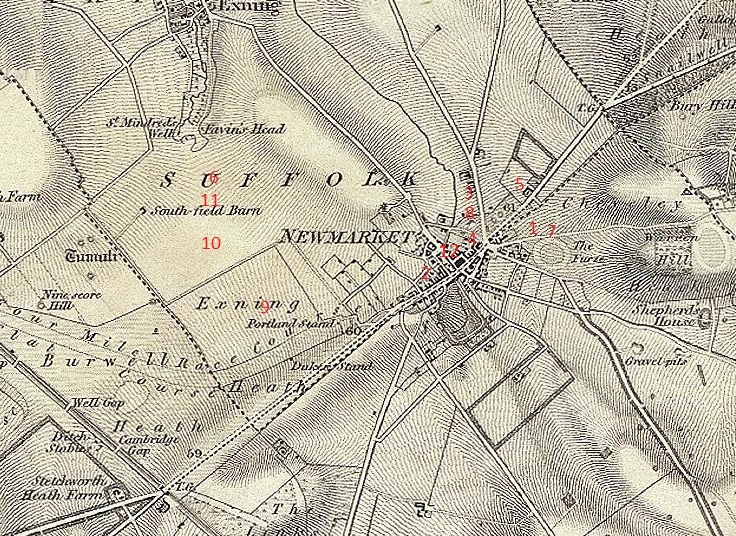
1861-1868 Robert Sly
What is clearer is that the site was being used as a racing stable by 1861 when Robert Sly was in charge. Robert, born in 1808, was a successful jockey for Lord Clifden before he became a trainer, training predominantly for Lord Clifden. He remained in charge until 1868, passing it on to the ex-Classic winning jockey Tommy Ashmall. Robert died of a fit in his Newmarket garden on Wednesday 19th December 1888 aged 80, and was buried just 3 days later on Saturday 22nd December 1888.
1868-1873 Thomas Ashmall
Robert was followed by another trainer, Thomas Ashmall, who was born in Rugeley, Staffordshire in 1838. He spent time in his early years at the stables of his uncle, Tom Carr, at Hednesford in Staffordshire, but his other claim to fame was that he was friends with John Porter at school. Porter went on to be one of the most accomplished trainers, winning no less than 23 English Classics, including 3 Triple Crown winners. He won the Epsom Derby 7 times, 1868 Blue Gown (SR 2042), 1882 Shotover (SR 2032), 1883 St Blaise (SR 1969), 1886 Ormonde (SR 2063), 1890 Sainfoin (SR 1968), 1891 Common (SR 2019), and 1899 Flying Fox (SR 2061). Tommy became apprentice to Thomas Taylor, going on to record 5 Classic successes. After a successful career as a jockey, cut short by an unfortunate incident with a horse, he joined the training ranks at Beaufort Cottage Stables and later in France. He died on 22nd May 1875.
1858 1000 Guineas and Oaks GOVERNESS (SR 1920) 15/2 owned by William Gratwicke, trained by Tom Eskrett and ridden by Tommy Ashmall
1860 2000 Guineas THE WIZARD (SR 1921) 20/1 owned by Anthony Nicol, trained by John Scott and ridden by Tommy Ashmall
1862 2000 Guineas THE MARQUIS (SR 1920) 5/1 owned by Stanhope Hawke, trained by John Scott and ridden by Tommy Ashmall
1862 1000 Guineas HURRICANE (SR 1887) 5/1 owned by 6th Viscount Falmouth, trained by John Scott and ridden by Tommy Ashmall
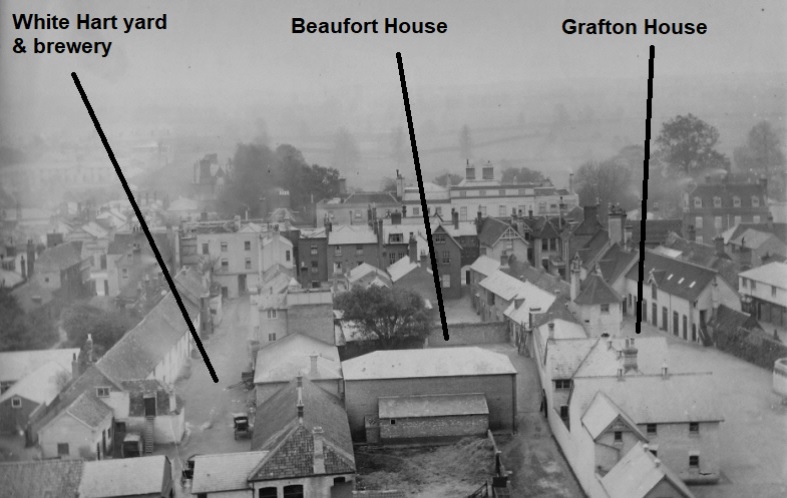
1873-1885 George Bloss
Ashmall moved to train in France and was replaced at Beaufort Cottage Stables by George Bloss in 1873. George had trained for Captain James Machell at Bedford Cottage between 1863 and 1872 before being replaced by Joe Cannon on Tuesday 18th February 1873. George had a further Classic success in 1877 when Belphoebe won the 1000 Guineas for the Marquis of Hartington. George, who resided in Cavendish House, which was within the ‘Beaufort’ estate, died on 14th September 1885, leaving the estate to his brother Charles Linch Bloss, who was also a trainer.
1877 1000 Guineas BELPHOEBE (SR 1800) 100/6 owned by Marquis of Hartington, trained by George Bloss and ridden by Harry Jeffery
1885-1896 Charles Linch Bloss
When brother George Bloss died in 1885 his estate passed to Charles who carried on training at Beaufort Cottage Stables while living at Cavendish House. He was less successful as a trainer than his Classic winning brother, and died at Cavendish House on 20th October 1896.
1897-1925 A H Rushtons Solicitors
Towards the turn of the century Beaufort House was taken over as business premises by A H Rushtons who were solicitors, but it was not used by them as a residence.
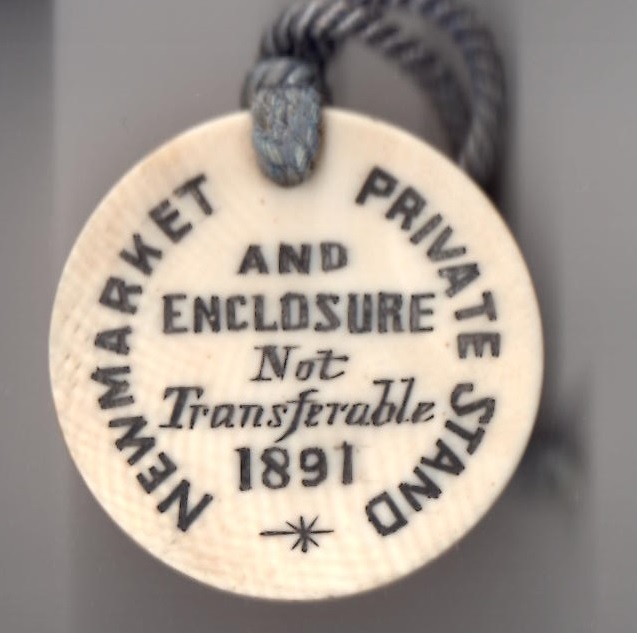
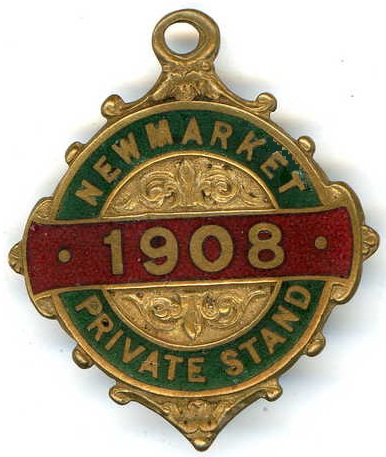
October 1913-August 1914 Richard Charles Marsh
Richard Charles 'Charlie' Marsh was born at Lordship Farm on 6 July 1882 and remained with his father until he was in his early twenties. He then went to Hungary for several years where he assisted John Reeves. In April 1907 he became private trainer to Mr W Brodrick Cloete at Hare Park at Six Mile Bottom and prepared his Cherimoya to win the 1911 Oaks when ridden by Fred Winter snr. From October 1913 he leased Beaufort House stables to train publicly, including some of Brodrick Cloetes horses, remaining there until 1914. From August 1914 'Charlie' Marsh served in the 3rd Hussars in which he was promoted Captain in early 1917. He was severely wounded in France. Demobbed in April 1919 and staying at Egerton House he looked for a post as a public or private trainer. Briefly from July 1919 he trained privately for Mr A E Barton and Sir Alec Black at Warren House.
Lord George Heneage Lawrence Dundas, son of Lord Zetland, was born in 1882. He launched his career as a racehorse trainer in Richmond, Yorkshire, but in 1912 he moved to Newmarket to train some of his father's horses at Beaufort Cottage Stables, although Initially he planned to occupy Cavendish House and its stables, but he lived for most of his Newmarket time at Hill Cottage and trained for the last twenty years of his career at Beaufort House, a little way across the town from his home. George Dundas was born in London on 1 July 1882, the third, but second surviving, son of the 1st Marquess of Zetland. Educated at Harrow he held a commission in the Argyll and Sutherland Highlanders from 1900 to 1906, including service in the South African War. Afterwards he turned to a career in racing, his early mentor being Sam Loates, who took over his stable horses early in the Great War when George was in service. He was recalled to the colours in 1914, serving as an ADC on the personal staff, before transferring to the RFC in 1915. He ended the War as a squadron commander (Major) and was mentioned in despatches. His poor eyesight was eventually uncovered and when he returned to the training ranks he always wore spectacles. Lord George trained Yutoi winner of the 1921 Cesarewitch and the Newbury Autumn Cup. His other winners included a Craven, Ribblesdale, Ascot Gold Vase, Ayr Gold Cup and Dewhurst. For his father he prepared the popular Pomme-De-Terre, winner of various races including the 1920 Manchester Cup and November Handicap and Prix du President at St Cloud. Racing politics eventually took their toll and he relinquished his licence at the end of August 1939 on the grounds of ill-health.
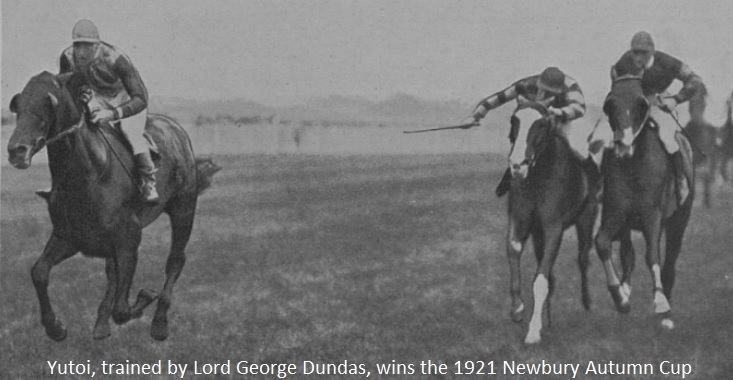
His brother, who had succeeded as Lord Zetland in 1929, planned to send his horses back north to Harry Peacock but circumstances rather overtook them. Health and eyesight regardless, Lord George was soon back in the RAF. During the Second World War Beaufort House was used as a food depot, Dick Perryman moving there in summer 1946. Dundas left Newmarket for 49 Hallam Street, W1, where he spent the rest of his life. He was, however, by no means finished with racing, becoming Chairman of the Hurst Park Syndicate which owned the racecourse. Hurst Park was always under threat from developers and the long-expected bid of £550,000 from a builder came in Summer 1959, Lord George leading the fight to save the course. 'It broke my heart', he commented when the fight was eventually lost. He died at his home on 30 September 1968 after a long illness.
1920 Manchester Cup POMME-DE-TERRE 3/1 fav owned by Lord Zetland, trained by Lord George Dundas and ridden by H Robbins
1920 Manchester November Handicap POMME-DE-TERRE 3/1 owned by Lord Zetland, trained by Lord George Dundas and ridden by H Robbins
1921 Prix du President de la Republique POMME-DE-TERRE owned by Lord Zetland, trained by Lord Dundas and ridden by H Robbins
1921 Cesarewitch Handicap at Newmarket YUTOI 100/8 owned by Mrs R Burnley, trained by Lord George Dundas and ridden by Henri Jelliss
1921 Newbury Autumn Cip YUTOI 6/1 owned by Mrs R Burnley, trained by Lord George Dundas and ridden by Henri Jelliss
1926 Ribblesdale Stakes at Royal Ascot ARTIST GLOW 4/1 owned by Mrs Charles Beatty, trained by Lord George Dundas and ridden by Charlie Elliott
1926 Ascot Gold Vase HIGH ART 20/1 owned by Sir George Noble, trained by Lord George Dundas and ridden by R James
1926 Dewhurst Stakes at Newmarket MONEY MAKER owned by Mrs Charles Beatty, trained by Lord George Dundas and ridden by Charlie Elliott
June 1915-1917 Lucien Niguet
Lucien Niguet was a famous figure in Belgian racing, commemorated by the Prix Lucien Niguet run appropriately at Ostende where he owned and trained winners of the Grand Prix. At the same time as running his Belgian stable he had horses in training at Newmarket at St Gatien from 1894, notably Sancho Panza. In autumn 1914, as the Germans invaded his country Lucien brought a little string to Epsom where he started training the following year with seven horses, all his own property. In June 1915 he moved to Beaufort House at Newmarket with his string of 7 horses, and remained there until 1917.
Francis William Bonnor Barling, son of a Gloucestershire farmer Frederick Barling, was born in 1869 in Ross-on-Wye and qualified as a Vet in Rugby before opening a practise in Monmouthshire. At the age of 32 he became interested in building up a stud of shire horses, but in 1906 he decided to launch his training career, starting at Hodcott House, West Ilsley. His biggest win whilst at West Ilsley was Subterranean, 11/2 winner of the 1912 Liverpool Spring Cup when owned by J Ellis Potter and ridden by W Huxley. After being commissioned in the AVC he then took out a short lease at Warren House, Newmarket between August and September 1915 before he returned to West Ilsley. He spent a further period at Warren House from August 1916 until March 1917. At this stage of his career he was a nomadic trainer, spending time at Beaufort House from April 1917, then departing for Falmouth Lodge from February 1918 where he trained for Lord Glanely, 1st Baron Glanely. He reached the pinnacle of his career when he trained the unexpected winner of the 1919 Epsom Derby Grand Parade (SR 1968) at 33/1 when ridden by Fred Templeman. It proved to be a spectacular year for both owner and trainer, recording 7 wins at Royal Ascot, all of which are listed in the Falmouth Lodge/Pegasus section of this site. Frank left Falmouth House when Lord Glanely purchased La Grange from George Blackwell in April 1920, but he then suffered a period of ill health which forced him to temporarily retire. However, once on the road to recovery he began enjoying farming again, and then yearned to return to the training ranks, spending time at Sefton Lodge from August 1923 until December 1924. Between 1925 and April 1926 he returned to La Grange, although his relationship with Lord Glanely deteriorated and Frank took out an extremely short lease at Saville House prior to renting Kremlin House from Joe Butters in August 1926, later purchasing it in 1927. In the latter part of his training career he was assisted by his son Geoff, especially during periods when his health was poor. During the time he operated from the various stables listed, he was also linked with a private stable from Primrose Cottage, passing it on to his son, Geof Bonnor Barling, in September 1934. Frank died in Newmarket on 17th April 1935.
1926-1941 George Jarvis, Henry Hopkins
In 1926, while the Rushtons were still occupying Beaufort House, George Jarvis was at Bedford Cottage, while Henry Hopkins was using Beaufort Stables. Leading up to the Second World War George Jarvis still trained on the site, but on 18th February 1941 Beaufort House was damaged by a bomb.
1921-1941 Richard Perryman (jockey)
Richard Perryman, universally known as Dick, was born in Brixton, London on 16th December 1903, the son of Percy William Perryman and Annie Schlenitz. Dick served his apprenticeship with Fred Leader, having his first ride in public in 1921 when aged 18. Dick married Dolly, the daughter of Robert Beedle, who was head lad to Robert Sherwood. Dick was retained by Lord Glanely before moving on to become jockey for trainer John Watson in 1926, riding the 1926 1000 Guineas winner Pillion (SR 1926). In 1928 he won the Cesarewitch on Arctic Star for Sir M Wilson, while the next year he captured the Ascot Gold Cup aboard Invershin. However, his most important retainer came in 1934 with Lord Derby, for whom he won the 1936 1000 Guineas with Tideway (SR 1825) and the 1936 Ascot Gold Cup for Lord Stanley, Lord Derby's son, with Quashed. He went on to ride a further One Thousand Guineas winner in 1941 with Dancing Time (SR 1934). In 1942, aged 39, he was involved in a car crash which forced him to retire as a jockey, but enabled him to launch his training career.
1925 Manchester Cup WINALOT 11/2 owned by Joseph Shepherd, trained by Fred Leader and ridden by Dick Perryman
1926 1000 Guineas PILLION (SR 1926) 25/1 owned by Anthony de Rothschild, trained by John Watson and ridden by Dick Perryman
1928 Cesarewitch ARCTIC STAR 9/1 owned by Sir M Wilson, trained by Tabor and ridden by Deick Perryman
1929 Ascot Gold Cup INVESHIN owned by John Reid Walker, trained by George Digby and ridden by Dick Perryman
1936 1000 Guineas TIDEWAY (SR 1825) 100/30 owned by 17th Earl of Derby, trained by Colledge Leader and ridden by Dick Perryman
1936 Ascot Gold Cup QUASHED owned by Lord Stanley, trained by Colledge Leader and ridden by Dick Perryman
1941 1000 Guineas DANCING TIME (SR 1934) 100/8 owned by Baron Glanely, trained by Joseph Lawson and ridden by Dick Perryman
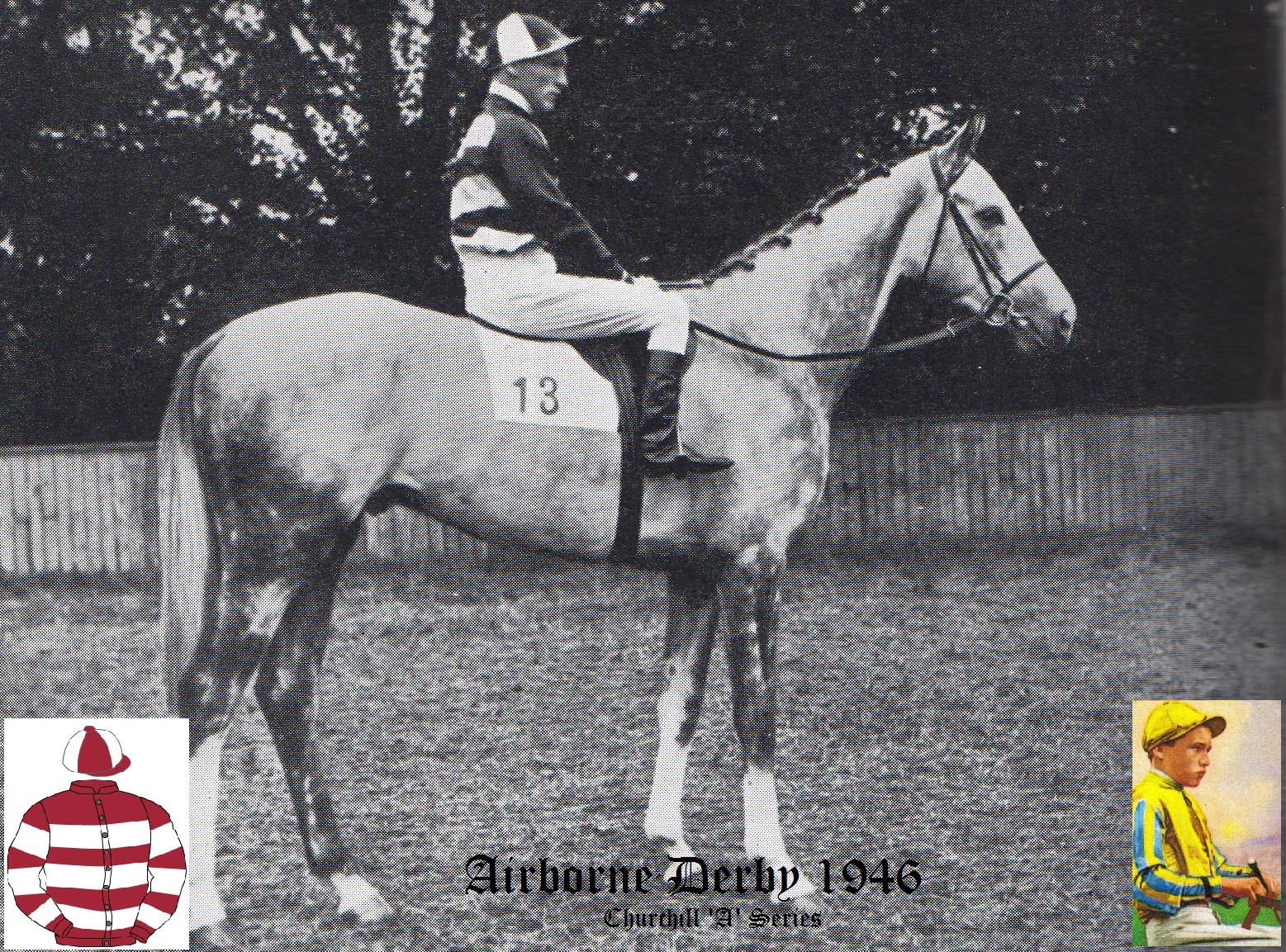
AIRBORNE (SR 1973)
Airborne, a grey colt by Precipitation out of Bouquet, was born in 1943 at Harold Boyd-Rochfort's stud at Castletown Geoghegan in County Westmeath. He was unsuccessful in 4 races as a two-year-old, and was only third in his first race at 3, before winning a lowly maiden at Newmarket over 1 1/2 miles. Unfancied for the 1946 Epsom Derby, the first to be run at Epsom since the outbreak of World War II in 1939, Airborne was sent off at 50/1, but delighted owner John E Ferguson and trainer Dick Perryman to win by a length from Gulf Stream. He went on to land the Prince of Wales's Stakes and the St Leger, but had no further successes at 4 and retired to stud.
1942-1960 Richard Perryman (trainer)
Dick trained at Beaufort House in Newmarket, which in those days stretched as far back as St Mary's Church, winning the 1945 St Leger with Chamossaire (SR 2029) for Stanhope Joel at 11/2 when ridden by his friend Tommy Lowrey. However, his most famous horse was the grey Airborne (SR 1973), who landed the 1946 Epsom Derby and the St Leger for owner John E Ferguson, both being piloted by Tommy Lowrey. His wins as a trainer after Airborne were run of the mill, and in 1960, when his lease expired, he was able to renegotiate the lease of Beaufort Cottage Stables and form an agreement with Bill Holden which allowed Bill to make use of the Beaufort Cottage Stables. Dick died in Newmarket on 22nd September 1976, aged 72, and his and his wife Dolly's ashes are scattered at The Bushes on Newmarket's Rowley Mile course. The Bushes, located 2 furlongs from the winning line, was a viewing spot favoured by King Charles II in the 17th century. To commemorate his life, Dick Perryman Court is named after him, and a bench dedicated to him is situated outside the jockey's weighing room on the racecourse.
1945 St Leger CHAMOSSAIRE (SR 2029) 11/2 owned by Stanhope Joel, trained by Dick Perryman and ridden by Tommy Lowrey
1946 Epsom Derby AIRBORNE (SR 1973) 50/1 owned by Mr John E Ferguson, trained by Dick Perryman and ridden by Tommy Lowrey
1946 St Leger AIRBORNE (SR 1973) 3/1 owned by Mr John E Ferguson, trained by Dick Perryman and ridden by Tommy Lowrey
1959-1971 William (Bill) Holden
William (Bill) Holden was born on 19th February 1930 and served his apprenticeship with Jack Reardon at Epsom. He successfully applied for a National Hunt jockey's licence in 1953, riding his first winner, Master Bob, at Towcester on 14th November 1953. His final winner came 5 years later aboard Hindu Flame at Leicester on 1st December 1958. He launched his training career in 1959, leasing stables from Dick Perryman at Beaufort Cottage, Newmarket. At the end of the 1960 season Dick Perryman renegotiated his lease of Beaufort Cottage Stables, and had an agreement with Bill Holden which allowed Bill to make use of the stables. Bill won the 1962 Esher Cup with Bucks King, while 4 years later he saddled Royal Yacht to victory in the 1966 Great St Wilfred Handicap at Ripon. In 1971 he moved from the centre of Newmarket to nearby Exning, where he trained for a further 21 years, retiring in 1992. He saddled 216 winners during his long career and enjoyed retirement in Spain. He died on 21st May 2020 aged 90, just 3 months after finding out that he had fathered a son, George Archer, and a daughter.
1962 Esher Cup at Sandown BUCKS KING 100/7 owned by B Nichols, trained by Bill Holden and ridden by Willie Snaith
1966 Great St Wilfred Handicap Stakes at Ripon ROYAL YACHT 100/8 trained by Bill Holden and ridden by Des Cullen
1960s-present
In the 1960s Beaufort Cottage became a veterinary practice run by Peter Rossdale, a practice which began in 1959 and celebrated its 50th Anniversary in 2019. Peter purchased Beaufort Cottage Stables on 5th January 1968.
CHAMOSSAIRE (1945 St Leger)
AIRBORNE (1946 Epsom Derby, St Leger)
BELPHOEBE (1877 1000 Guineas)
POMME-DE-TERRE (1920 Manchester Cup, Manchester Handicap)
YUTOI (1921 Cesarewitch Handicap. Newbury Autumn Cup)



